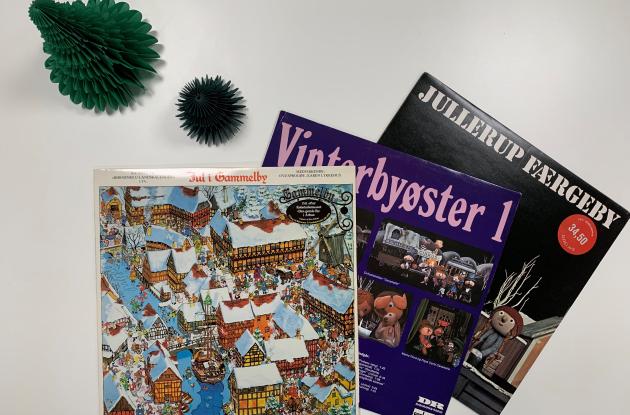The Danish TV Christmas calendars on the charts
With senior researcher Henrik Smith-Sivertsen, we delve into the TV Christmas calendars of the past decades and investigate how they have cracked the code for Christmas songs that hit the charts.
In the month of December, the charts all over the world change drastically. Down the list are the new songs, which otherwise dominate the charts all other months of the year, and in come the classic - some would say overplayed - Christmas hits such as "All I Want for Christmas Is You" by Mariah Carey (1994) and Wham!'s "Last Christmas" (1986). In Denmark, however, the charts in December look a bit different than in the rest of the world. Here, the Christmas hits from the last several years' TV Christmas calendars also storm onto the hit list and fight for first place.
We spoke to Henrik Smith-Sivertsen, who works as a senior researcher in the special collections at Royal Danish Library, and together with him we delve into the history of TV Christmas calendars and how it is that the Christmas songs from them enter the Danish hit music lists year after year in the month of December.
The origin of the TV Christmas calendar
The TV Christmas calendar originates from Sweden, where the first Christmas calendar was broadcast on television in 1960. The phenomenon was invented as a supplement to the printed Christmas calendar, where what was hidden behind the door of the day unfolded as entertainment on television the same evening. The TV Christmas calendar quickly spread to the rest of Scandinavia, and the first one rolled across the screen in Denmark on DR in 1962. The TV Christmas calendar was for children and was called Historier fra hele verden. Ever since, TV Christmas calendars have been broadcast in prime time in the days leading up to Christmas in December.
Vinterbyøster, ja Vinterbyøster – det’ der jeg er post
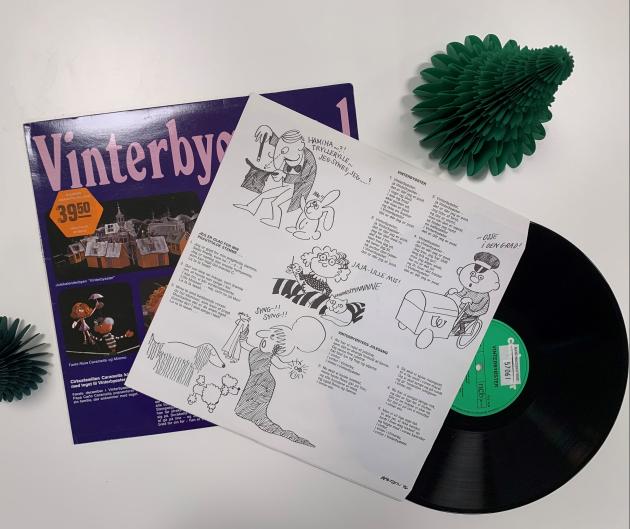
Photo: Det Kgl. Bibliotek
This is how the first line of the song "Vinterbyøster" from the Christmas calendar of the same name sounds. It was shown on DR for the first time in 1973 and can celebrate its 50th anniversary this year. Vinterbyøster was about the Caramella doll family from Circus Caramella, who came to the station town of Vinterbyøster every year.
In 1968, Danmark Radio established their Children and Youth Department, and they had good experience with using puppets and songs in children's television. They had already brought the dolls into the TV Christmas calendar the year before, and songs also took up much more space in the TV Christmas calendar in 1973. Here, they invested heavily in music and songs, and a soundtrack was released for the Christmas calendar
, says Henrik Smith-Sivertsen.
Both the puppets and the carols in Vinterbyøster proved to be a great success. The soundtrack hit the charts in December, while the Christmas calendar rolled across the screen, and it stayed on the charts right into March, when Christmas was long over.
Jullerup Færgeby
The following year, in 1974, DR showed the Christmas calendar Jullerup Færgeby. Many can hum along to the melody from the song "Fire Strømper Uden Fod" from the Christmas calendar, where the first verse reads:
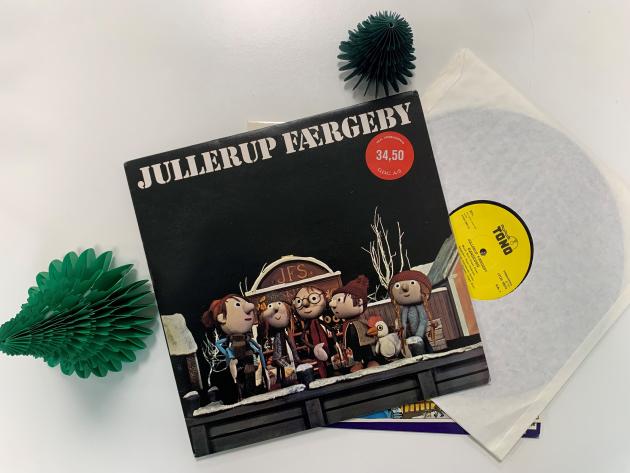
Photo: Det Kgl. Bibliotek
”Fire strømper uden fod,
en tomat så rød som blod
og en gammel gulerod
ka’ du få for en krone”.
The song was written by Asger Pedersen and composed by Niels Jørgen Steen, and it, like the Christmas hit from the Christmas calendar the year before, entered the Danish charts in December.
You knew from other children's TV that recurring songs worked well. It was therefore not only the title melody that repeated itself in each episode. When, for example, a certain character came on the screen, it also gave rise to bursting into song. The recurring songs caught on with both children and adults and were hummed all Christmas
, says Henrik Smith-Sivertsen.
A quirky example of one of the many recurring songs is from DR's Christmas calendar Kikkebakke Boligby, which was broadcast in 1977 and was written by Ole Lund Kirkegaard (1940-1979). In this, the main character's father was so enthusiastic about washing dishes that he had to break out into "Opvaskesangen" every time. The song possibly came in response to the fact that Jullerup Færgeby had faced criticism from members of the red stocking movement. They believed that the Christmas calendar was oppressive to women, among other things, because it was always the mother in the Christmas calendar who washed the dishes and mended torn trousers. The criticism was taken into account and out of it came "Opvaskesangen" ("The Washing Dishes Song").
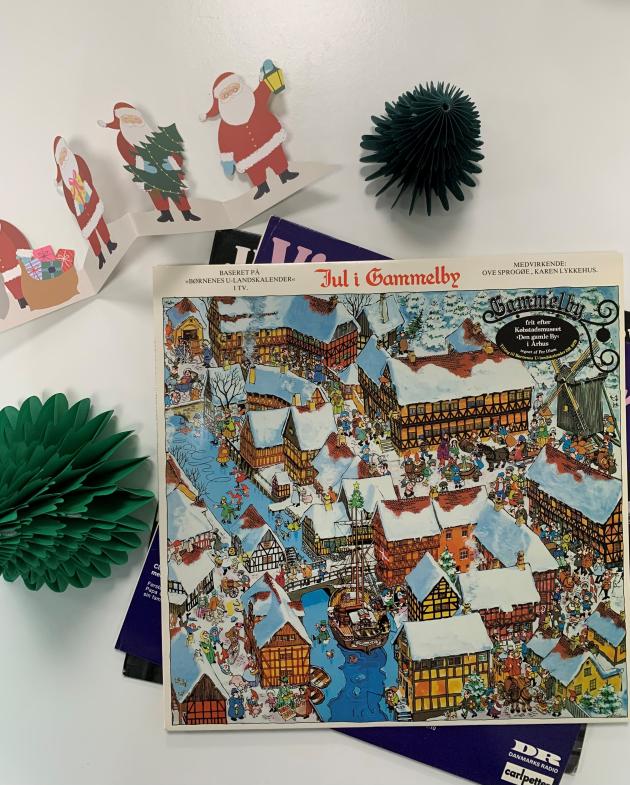
Photo: Det Kgl. Bibliotek
A proper Christmas calendar
In December 1979, the Christmas calendar Jul i Gammelby came out, which really revolutionised the format for traditional TV Christmas calendars. Partly because the dolls were replaced with real actors.
Jul i Gammelby was the largest production of TV Christmas calendars in Denmark to date. It came in the same year that DR showed the second season of their hugely successful series Matador, and the similarities between the two series were spot on. And then, of course, a soundtrack was also made that the viewers could sing along to
, says Henrik Smith-Sivertsen and continues:
In addition, the printed version of the Christmas calendar and the album cover had the same image. It was quite cleverly thought out, because first the children had to have the printed version of the Christmas calendar, in the evening they could see the picture from the day's cover play out as the entertainment on the television, and then the parents could go down to the gramophone shop and buy the record with the soundtrack as a Christmas present. Jul i Gammelby was everywhere
.
The fight for first place
If you take a look at the charts of the last several years in the month of December, however, it is not the Christmas songs from Vinterbyøster, Jullerup Færgeby or Jul i Gammelby that are on the list. It is rather Christmas hits from the TV Christmas calendars from the late 90s onwards. Regulars are, for example, "Jesus and Josefine" by Julie Berthelsen and Martin Brygmann from the Christmas calendar of the same name, which was broadcast on TV2 in 2003, and "I En Stjerneregn Af Sne" by Mads Langer from the Christmas calendar Tvillingerne og Julemanden, which rolled across the screen on TV2 in 2013.
Previously, the songs for the TV Christmas calendars were written so that they fit the plot and theme of the particular Christmas calendar for which they had been produced. But in the 1990s, the songs began to sound more like the mainstream pop music that was otherwise found on the charts. This may be because the CD had its breakthrough in the 80s, and it changed the way we listened to music. Now it was suddenly much easier to change songs - and you didn't have to turn the record over after 6 songs! In the 1990s, you started making Christmas compilations, which were CDs, where you collected different Christmas hits on one CD, and that changed the way you produced Christmas music
, says Henrik Smith-Sivertsen.
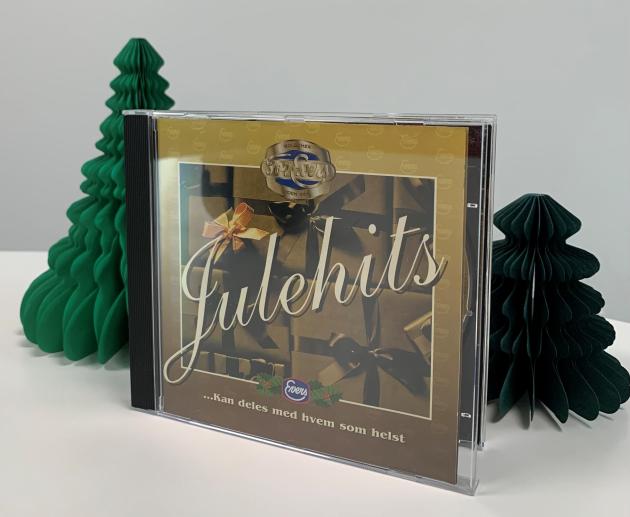
Photo: Det Kgl. Bibliotek
What the Christmas songs that got a place on the track list had in common was their similarity and that they fit into the repertoire. The CDs came out year after year with more or less the same track list, and if you had your Christmas song on there, there was a good probability that it would be one that the Danes would sing along to throughout Christmas. The teams behind the TV Christmas calendars were naturally also in the race to get a place on the Christmas compilation's track list and make the year's new Christmas hit, and therefore the Christmas carols in the TV Christmas calendars began to sound more and more like the traditional and mainstream Christmas music. Today, Christmas compilations have been replaced by playlists on various online music services, but the competition for first place still continues.
The fact that it is the same Christmas classics that have burst onto the charts in December for the past several years can simply be due to the fact that Christmas is to that extent the time of traditions - and just like how we bring out our Christmas decorations, every year we find the old Christmas classics, we know and love, and play them again.
